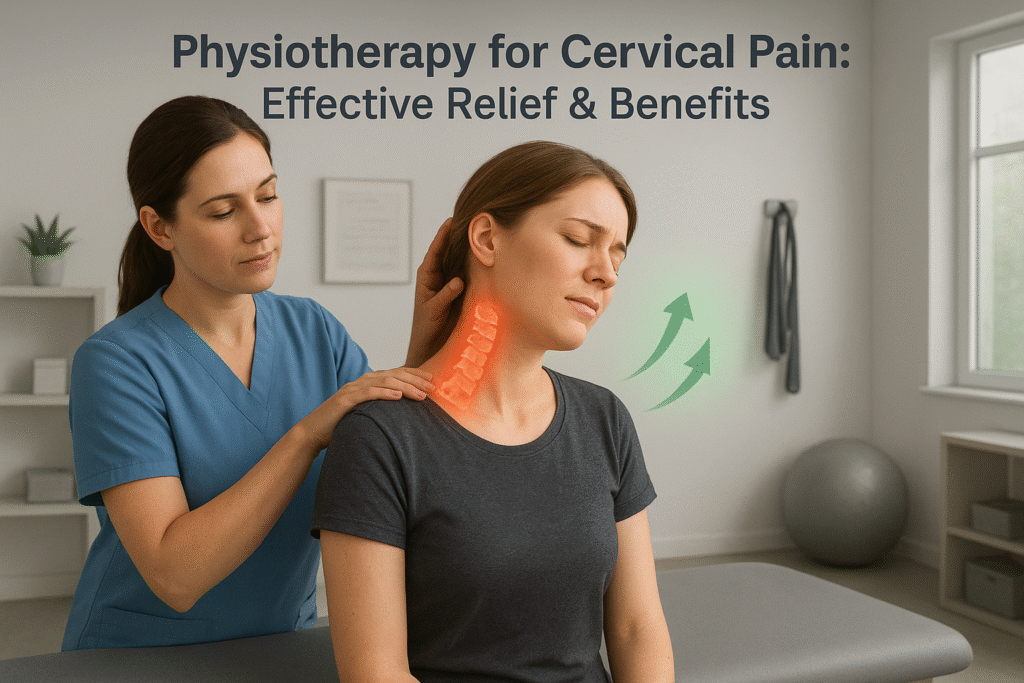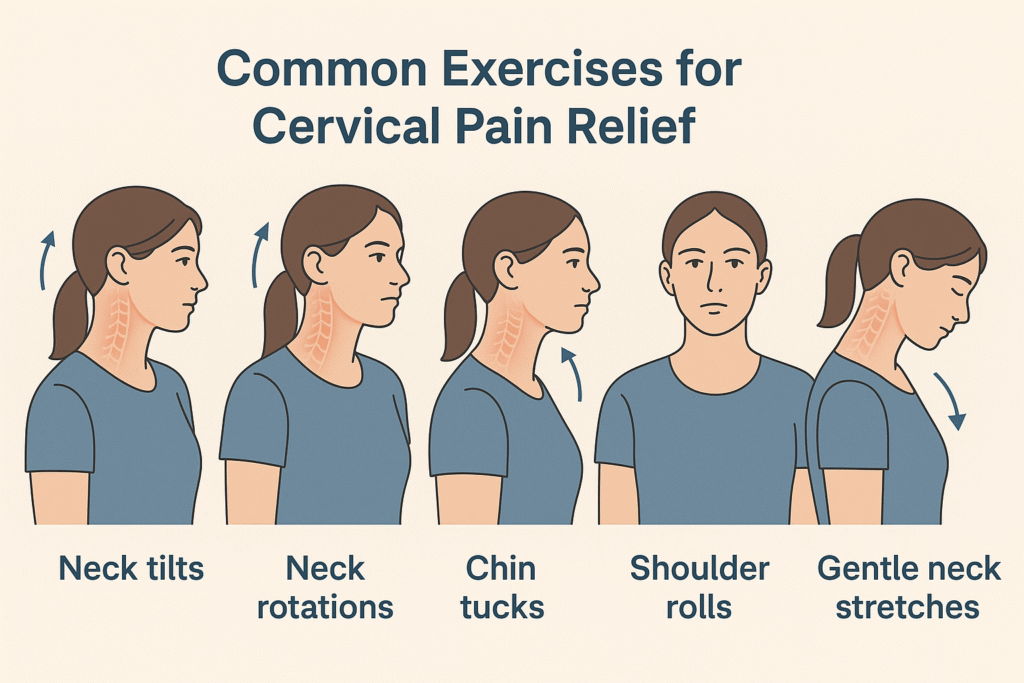
Neck pain has quietly become one of the most common health challenges of modern times. If you live in a city, you’ve probably seen colleagues rubbing their necks after long meetings, friends complaining of stiffness after late-night phone scrolling, or even family members struggling to turn their heads in the morning. In fact, cervical pain — often linked to cervical spondylosis, cervical disc issues, or muscle strain — is now considered a global musculoskeletal concern.
According to the World Health Organization (WHO), musculoskeletal conditions are among the leading causes of disability worldwide, and neck pain is consistently reported as one of the top contributors. A large population-based study published in The Lancet revealed that neck pain affects more than 20% of people at some point in their lives. In India, urban professionals are particularly vulnerable due to long desk hours, while manual workers in rural areas develop cervical problems from repetitive strain and heavy lifting.
This growing burden of cervical pain highlights the importance of safe, effective, and sustainable solutions. While medications can reduce pain temporarily, they rarely fix the root cause. Surgery, although necessary in some advanced cases, is invasive and not always required. Physiotherapy, on the other hand, has emerged as one of the most evidence-backed, non-invasive, and patient-friendly approaches for cervical pain management.
In this article, we’ll take a deep dive into:
- What cervical pain really is and why it happens.
- The science of physiotherapy for cervical spine problems.
- Evidence-based physiotherapy techniques and their benefits.
- Exercises, ergonomic tips, and preventive strategies.
- The role of physiotherapy in India’s growing cervical pain epidemic.
- When to seek professional help.
Our aim is to make this a comprehensive, factual, and actionable guide for anyone struggling with cervical discomfort or looking to protect their neck health for the future.
Understanding Cervical Pain
What is Cervical Pain?
The cervical spine is the uppermost part of the spinal column, consisting of seven vertebrae (C1–C7). This region supports the skull, allows head movement, and protects vital nerves that connect the brain to the rest of the body. Because of its flexibility and constant use, the cervical spine is highly prone to wear and tear, postural strain, and injury.
Cervical pain typically refers to:
- Localized pain in the neck region.
- Stiffness or reduced range of motion.
- Pain radiating to shoulders, arms, or upper back.
- In severe cases, nerve compression symptoms like tingling or numbness.
Common Causes of Cervical Pain
Medical literature highlights several causes, many of which overlap due to lifestyle and ageing factors:
Poor Posture
- Forward head posture from laptops and phones.
- Slouching during long desk hours.
- Muscle Strain
- Prolonged sitting without breaks.
- Heavy lifting or sudden jerks.
- Degenerative Changes
- Cervical spondylosis (age-related disc and joint wear).
- Osteoarthritis of the neck joints.
- Disc Problems
- Herniated or bulging cervical discs pressing on nerves.
- Trauma or Accidents
- Whiplash injuries from car accidents.
- Sports injuries.
- Lifestyle Factors
- Stress and anxiety leading to neck muscle tension.
- Lack of physical activity.
- Other Medical Conditions
- Infections, inflammatory disorders, or tumors (rare but important).
Symptoms to Watch Out For
- Persistent neck stiffness.
- Sharp or aching pain in the neck.
- Radiating pain to shoulders or arms.
- Tingling or numbness in fingers.
- Weakness in grip strength.
- Headaches starting from the base of the skull.
- Dizziness or balance issues in severe cervical spondylosis.
Understanding these causes and symptoms is the first step before exploring how physiotherapy can help.
Why Physiotherapy is Essential for Cervical Pain
Physiotherapy stands out for one main reason: it treats the root cause rather than masking symptoms.
Evidence-Based Benefits of Physiotherapy
According to the National Institute for Health and Care Excellence (NICE, UK) and multiple studies indexed on PubMed, physiotherapy is highly effective for non-specific neck pain, cervical spondylosis, and disc-related conditions.
Key advantages include:
- Non-invasive: Avoids risks of surgery.
- Drug-free: Reduces dependency on painkillers.
- Personalized: Tailored programs for each patient.
- Restorative: Improves function and mobility.
- Preventive: Reduces risk of recurrence.
How Physiotherapy Works
Physiotherapy combines manual therapy, exercises, ergonomic advice, and patient education to:
- Reduce pain and inflammation.
- Restore range of motion.
- Strengthen supporting muscles.
- Correct postural imbalances.
- Relieve pressure on nerves.
- Improve blood flow and tissue healing.
Instead of offering just short-term comfort, physiotherapy focuses on long-term recovery and prevention.
Physiotherapy Techniques for Cervical Pain
Here’s a detailed look at evidence-based techniques:
1. Manual Therapy
Hands-on mobilization to restore normal movement and reduce stiffness.
- Joint Mobilization – Gentle oscillations applied to stiff cervical joints.
- Soft Tissue Manipulation – Massage to reduce muscle tightness.
- Myofascial Release – Targets deep connective tissue.
2. Exercise Therapy
Central to every physiotherapy program.
- Range of Motion Exercises – Neck rotations, side bends.
- Strengthening Exercises – Chin tucks, isometric holds, scapular retractions.
- Stretching – Trapezius and levator scapula stretches.
- Postural Training – Reversing forward head posture.
3. Electrotherapy
Machines that stimulate muscles and nerves.
- TENS (Transcutaneous Electrical Nerve Stimulation).
- Ultrasound Therapy – Promotes deep tissue healing.
- Interferential Therapy (IFT) – Pain modulation.
4. Heat and Cold Therapy
- Moist Heat Packs – Increase circulation and relax muscles.
- Cold Packs – Reduce inflammation in acute injuries.
5. Cervical Traction
- Gentle pulling force that relieves nerve compression by creating space between vertebrae.
6. Ergonomic Guidance
- Advice on correct sitting posture, workstation setup, and sleeping habits.
7. Neurodynamics
- Special mobilizations for compressed or irritated nerves.
8. Relaxation and Breathing Exercises
- Stress management reduces muscle tension and prevents flare-ups.
Benefits of Physiotherapy for Cervical Pain
Short-Term Benefits
- Pain reduction.
- Relief from stiffness.
- Muscle relaxation.
- Improved neck mobility.
Long-Term Benefits
- Strengthened neck and shoulder muscles.
- Corrected posture.
- Reduced recurrence.
- Improved daily functioning.
Psychological Benefits
- Reduced fear of chronic pain.
- Empowerment through self-care strategies.
Always consult a physiotherapist first.
- Chin Tucks – Gently pull chin backward.
- Neck Rotations – Slowly look left and right.
- Upper Trapezius Stretch – Tilt head sideways.
- Scapular Retractions – Pinch shoulder blades together.
- Isometric Neck Exercises – Press head against hand without moving.
Consistency is key. Doing these daily can significantly reduce cervical pain risk.

Ergonomics & Lifestyle Modifications
Desk Setup
- Screen at eye level.
- Chair with lumbar and cervical support.
- Keyboard and mouse at comfortable height.
Daily Habits
- Take breaks every 30–45 minutes.
- Avoid long hours on smartphones (“tech neck”).
- Use both straps of a backpack.
- Practice mindful posture checks.
Sleep Hygiene
- Medium-firm mattress.
- Cervical pillow for proper alignment.
Cervical Pain in India – A Growing Concern
- Studies in the Indian Journal of Orthopaedics show nearly 34% of office workers report frequent neck pain.
- In IT hubs like Bengaluru and Pune, neck and back pain are leading causes of sick leaves.
- Rural women carrying heavy loads on their heads often develop chronic cervical strain.
- With increased gadget use, even teenagers are developing “text neck.”
This shows why awareness and physiotherapy interventions are urgently needed in India.
When to Seek Medical Help
Seek immediate medical care if you experience:
- Pain lasting more than 2–3 weeks.
- Weakness or numbness in arms/fingers.
- Loss of coordination or balance.
- Severe headaches with neck stiffness.
- Sudden severe pain after trauma.
Early physiotherapy can prevent long-term disability.
Role of We Are Spine
At We Are Spine, the approach to cervical pain is comprehensive. The team focuses on:
- Accurate diagnosis using clinical assessments and imaging.
- Personalized physiotherapy plans.
- Ergonomic training for workplaces and homes.
- Preventive education to stop recurrence.
This holistic care ensures that patients not only recover from pain but also maintain long-term spinal health.
Myths vs Facts About Cervical Pain
- Myth: Neck pain always requires surgery.
-Fact: Most cases improve with physiotherapy and lifestyle changes. - Myth: Rest is the best treatment.
-Fact: Prolonged rest weakens muscles; guided movement is essential. - Myth: Cervical pain is only age-related.
-Fact: Increasingly common among young adults due to posture issues.
Conclusion
Cervical pain is not just a nuisance; it’s a growing lifestyle health concern that can affect productivity, mental well-being, and quality of life. While medications may provide quick relief, physiotherapy offers a comprehensive, safe, and sustainable solution.
By combining manual therapy, exercises, ergonomic corrections, and patient education, physiotherapy addresses both symptoms and causes. With rising cases in India due to desk jobs and digital habits, spreading awareness about physiotherapy is more important than ever.
If you’re experiencing cervical discomfort, don’t ignore it. Early intervention through physiotherapy can mean the difference between occasional stiffness and long-term chronic pain. Protect your neck today — because a healthy spine is the backbone of an active, fulfilling life.